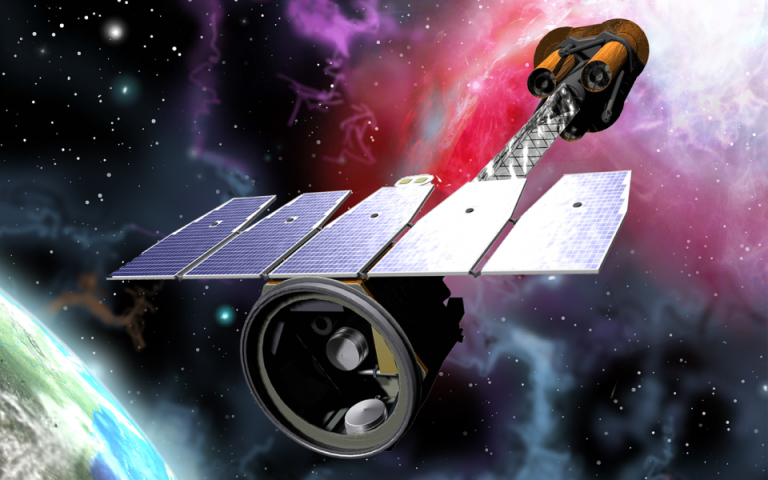Prestigious prize for NASA’s mission involving UCL Space and Climate Physics scientists
2 February 2024
Professors Silvia Zane and Kinwah Wu are part of the NASA’s Imaging X-ray Polarimetry Explorer (IXPE) team that has recently been awarded the 2024 Bruno Rossi Prize, top prize in high-energy astronomy.

The High Energy Astrophysics Division of the American Astronomical Society (AAS) has awarded the 2024 Bruno Rossi Prize to NASA astrophysicist Martin Weisskopf, Italian Space Agency’s Paolo Soffitta, and the whole mission team for the development of IXPE, the Imaging X-ray Polarimetry Explorer, “whose novel measurements advance our understanding of particle acceleration and emission from astrophysical shocks, black holes and neutron stars,” according to the AAS announcement.
Launched on 9 December 2021, and developed by NASA, the Italian Space Agency, and partners in a dozen countries around the globe, IXPE orbits Earth some 340 miles up to observe X-ray emissions from powerful cosmic phenomena hundreds or thousands of light-years from Earth. It is the first ever space mission carrying instruments capable to make polarimetric observations of X-ray sources, thanks to the technology development of new generation detectors based on the photoelectric effect.
Polarimetry measures the amplitude and direction of the oscillation of the electric field of electromagnetic waves, and this carries unique information on state of the matter that emits the signal and on the tri-dimensional structure of the source. Thanks to IXPE, X-ray polarimetry has now joined X-ray imaging, spectroscopy and timing and is one of the main observational techniques in high energy astrophysics.
In the two years following its launch, IXPE has measured the polarised X-ray emission from virtually all classes of bright X-ray sources, including blazars such as Markarian 501 and Markarian 421, supernova remnants as Tycho and SN 1006, several ultra-magnetised neutron stars, and the supermassive black hole at the centre of our own galaxy.
IXPE is also prepared to study unanticipated cosmic events – such as the brightest pulse of high-energy radiation ever recorded, which swept through Earth’s solar system in late 2022. IXPE’s success led NASA to formally extend the mission for an additional 20 months, through at least September 2025.
Professor Wu said: “I started when I was a researcher at NASA-MSFC with the IXPE PI Martin Weisskopf and was among the ten non-NASA researchers on the original proposal for XPE, which eventually evolved to become IXPE. I am delighted that the research of IXPE was recognised and hope the current work of the IXPE researchers paves the way for more discoveries and advancement in high-energy astrophysics.”
Professor Zane said: “IXPE is a revolutionary instrument that is giving us a new view of the X-ray Universe, revealing the tri-dimensional structure of flows, magnetic fields and spacetime around high energy sources.
“We are looking at the X-ray sky with polarised glasses. This is allowing us to resolve intricated details of the structure of sources that would be otherwise seen as point-like objects: for instance, it is showing us what the status of the plasma is in different zones at the surface of a neutron star and whether it is solid or gaseous. IXPE’s imaging capabilities are revealing the finest details of shocks in supernovae remnants.
“Having the possibility to observe these X-ray sources with a polarimeter is a dream come true. We have been pursuing the idea for many years, proposing similar mission designs to several agencies, and NASA has realised the mission. IXPE is a pathfinder, and we now wish to expand the energy range accessible for X-ray polarimetry. In this respect, what we are learning with IXPE will be crucial to drive the design of many other future X-ray polarimetry space missions. On 1 January this year, India successfully launched its first dedicated X-ray polarimetry mission, XPoSat, and we expect several major space agencies across the world to follow in the future.
“I am honoured to be part of this successful team, and it has been amazing to receive the news of the award of the Bruno Rossi Prize."
The prize is in honour of Professor Bruno Rossi, an authority on cosmic ray physics and a pioneer in the field of X-ray astronomy. It is the highest distinction in high energy astrophysics. The prize includes an engraved certificate, a $1,500 award and a lecture given by the recipient at the 245th meeting of the AAS in January 2025.
Links
- Original article on NASA’s website
- IXPE mission
- The Bruno Rossi Prize
- The High Energy Astrophysics Division of the American Astronomical Society
- Professor Kinwah Wu’s academic profile
- Professor Silvia Zane’s academic profile
- UCL Space and Climate Physics
Image
- An artist’s illustration of the IXPE spacecraft in orbit, studying high-energy phenomena light-years from Earth. Source: NASA.
Media contact
Ingrida Bertasiute
E: i.bertasiute [at] ucl.ac.uk
 Close
Close

